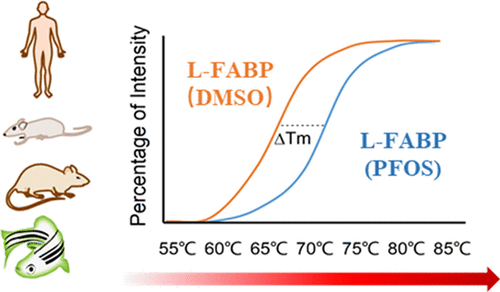当前位置:
X-MOL 学术
›
Environ. Sci. Technol.
›
论文详情
Our official English website, www.x-mol.net, welcomes your
feedback! (Note: you will need to create a separate account there.)
Quantitative Chemical Proteomics Reveals Interspecies Variations on Binding Schemes of L-FABP with Perfluorooctanesulfonate
Environmental Science & Technology ( IF 10.8 ) Pub Date : 2021-06-16 , DOI: 10.1021/acs.est.1c00509 Jiajun Han 1 , Jesse Fu 1 , Jianxian Sun 1 , David Ross Hall 1 , Diwen Yang 1 , Donovan Blatz 2 , Keith Houck 3 , Carla Ng 4 , Jon Doering 5 , Carlie LaLone 6 , Hui Peng 1, 7
Environmental Science & Technology ( IF 10.8 ) Pub Date : 2021-06-16 , DOI: 10.1021/acs.est.1c00509 Jiajun Han 1 , Jesse Fu 1 , Jianxian Sun 1 , David Ross Hall 1 , Diwen Yang 1 , Donovan Blatz 2 , Keith Houck 3 , Carla Ng 4 , Jon Doering 5 , Carlie LaLone 6 , Hui Peng 1, 7
Affiliation

|
Evaluating interspecies toxicity variation is a long-standing challenge for chemical hazard assessment. This study developed a quantitative interspecies thermal shift assay (QITSA) for in situ, quantitative, and modest-throughput investigation of chemical–protein interactions in cell and tissue samples across species. By using liver fatty acid binding protein (L-FABP) as a case study, the QITSA method was benchmarked with six per- and polyfluoroalkyl substances, and thermal shifts (ΔTm) were inversely related to their dissociation constants (R2 = 0.98). The QITSA can also distinguish binding modes of chemicals exemplified by palmitic acid. The QITSA was applied to determine the interactions between perfluorooctanesulfonate (PFOS) and L-FABP in liver cells or tissues from humans, mice, rats, and zebrafish. The largest thermal stability enhancement by PFOS was observed for human L-FABP followed by the mouse, rat, and zebrafish. While endogenous ligands were revealed to partially contribute to the large interspecies variation, recombinant proteins were employed to confirm the high binding affinity of PFOS to human L-FABP, compared to the rat and mouse. This study implemented an experimental strategy to characterize chemical–protein interactions across species, and future application of QITSA to other chemical contaminants is of great interest.
中文翻译:

定量化学蛋白质组学揭示 L-FABP 与全氟辛烷磺酸结合方案的种间差异
评估种间毒性变化是化学危害评估的长期挑战。本研究开发了一种定量种间热位移测定法 (QITSA),用于对跨物种的细胞和组织样品中的化学-蛋白质相互作用进行原位、定量和中等通量研究。以肝脏脂肪酸结合蛋白 (L-FABP) 为案例研究,QITSA 方法以六种全氟和多氟烷基物质为基准,热位移 (Δ T m ) 与其解离常数 ( R 2= 0.98)。QITSA 还可以区分以棕榈酸为例的化学物质的结合模式。QITSA 用于确定人类、小鼠、大鼠和斑马鱼肝细胞或组织中全氟辛烷磺酸 (PFOS) 和 L-FABP 之间的相互作用。在人类 L-FABP 中观察到 PFOS 对热稳定性的最大增强作用,其次是小鼠、大鼠和斑马鱼。虽然发现内源性配体部分促成了大的种间变异,但与大鼠和小鼠相比,重组蛋白被用来证实 PFOS 与人 L-FABP 的高结合亲和力。本研究实施了一种实验策略来表征跨物种的化学-蛋白质相互作用,未来将 QITSA 应用于其他化学污染物具有极大的兴趣。
更新日期:2021-07-06
中文翻译:

定量化学蛋白质组学揭示 L-FABP 与全氟辛烷磺酸结合方案的种间差异
评估种间毒性变化是化学危害评估的长期挑战。本研究开发了一种定量种间热位移测定法 (QITSA),用于对跨物种的细胞和组织样品中的化学-蛋白质相互作用进行原位、定量和中等通量研究。以肝脏脂肪酸结合蛋白 (L-FABP) 为案例研究,QITSA 方法以六种全氟和多氟烷基物质为基准,热位移 (Δ T m ) 与其解离常数 ( R 2= 0.98)。QITSA 还可以区分以棕榈酸为例的化学物质的结合模式。QITSA 用于确定人类、小鼠、大鼠和斑马鱼肝细胞或组织中全氟辛烷磺酸 (PFOS) 和 L-FABP 之间的相互作用。在人类 L-FABP 中观察到 PFOS 对热稳定性的最大增强作用,其次是小鼠、大鼠和斑马鱼。虽然发现内源性配体部分促成了大的种间变异,但与大鼠和小鼠相比,重组蛋白被用来证实 PFOS 与人 L-FABP 的高结合亲和力。本研究实施了一种实验策略来表征跨物种的化学-蛋白质相互作用,未来将 QITSA 应用于其他化学污染物具有极大的兴趣。










































 京公网安备 11010802027423号
京公网安备 11010802027423号